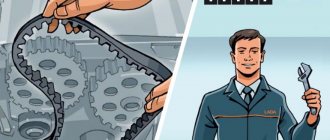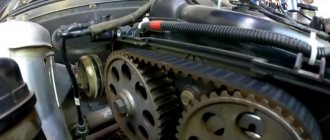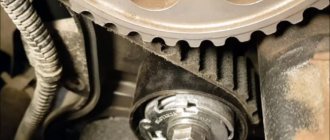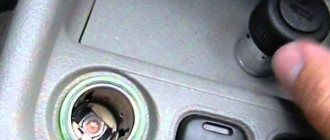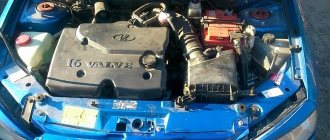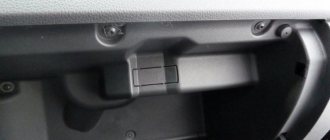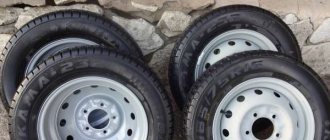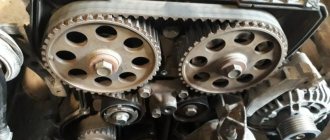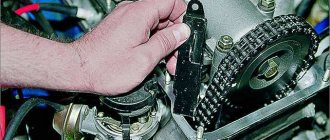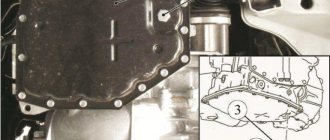In the gas distribution system, the belt is of particular importance. It is he who is responsible for the possibility of connecting the crankshaft and camshaft. In addition, without this drive, synchronous operation of the pistons in the cylinders and the intake/exhaust valves is impossible. The timing belt turns the camshaft pulley exactly half a revolution of the crankshaft pulley.
Quality and reliability are especially important in engines where the piston and valve group are a single unit, for example, like Kalina’s. Why should every car owner know how to change the timing belt on Kalina? The valves and pistons are located in the same block, but thanks to the belt they do not touch. Accordingly, when they break, the pistons hit the valves, which leads to expensive engine repairs.
Timing belt tension on Kalina
This Lada has two types of engines. On a 16-valve internal combustion engine, an automatic timing belt tensioner is used, and on an engine with 8 valves, a tensioner roller is installed. In the case of a roller, the tension should be checked every 10-15 thousand kilometers and replaced after 75,000 kilometers.
On a 16-valve engine, you do not need to tighten it yourself; there is an automatic mechanism for this. The belt in such motors lasts longer. But, on the other hand, it is possible that the tensioner may fail or oil may get onto the teeth due to a faulty crankshaft oil seal. Breakage or wear of its teeth will lead to disruption of the gas distribution mechanism and subsequent repair of the internal combustion engine. Therefore, you should not rely only on the automatic mechanism and periodically check the wear status of the part during maintenance.
To carry out the procedure for tensioning the timing belt on a drive with a tensioner pulley, you will need a special wrench. The algorithm of actions is as follows.
- Using a 10mm wrench, unscrew the bolts securing the drive cover, lift it up and remove it.
- Rotate the timing drive mechanism by the camshaft pulley mounting nut, thereby assessing the degree of belt wear. There should be no oil stains, cracks, delaminations on the surface of the belt, and the teeth should not be worn out.
- At the middle level (between the camshaft and crankshaft pulleys), you should turn the belt 90 degrees to the right and left, without applying significant force. If the force is not enough to turn the belt 90 degrees, it means it is too tight and needs to be loosened. Accordingly, if the belt turns to a larger angle, it should be tightened.
To adjust the tension, you will need to cool the engine and use a 17mm spanner to loosen the tensioner roller fastener. Next, you will need a special key with which you need to turn the roller to the right or left (to tighten or loosen), after which, holding the key in the desired position, tighten the roller fastening nut. After this, the tension level is assessed again. If necessary, the procedure is repeated. If the belt is tensioned as required, you can put on the protective cover and secure it with three fastener bolts.
For a 16-valve engine equipped with an automatic tensioning mechanism, a similar procedure is not provided.
Choosing a timing repair kit for Lada Kalina
The quality of the belt and roller is very important, since the smooth operation of the engine depends on it. The issue should be approached with all responsibility. On the other hand, this is a consumable item, which means you still have to change it.
The Lada Kalina is equipped with a timing belt with number 21126-1006040 from the factory. The original is considered one of the best and is highly reliable, on average it lasts for 50,000 kilometers. The cost varies depending on the region: 1,000–1,500 rubles. There are a large number of analogues on the modern market, which are usually cheaper.
But there are also more expensive examples. The following brands became the most popular:
- Gates (on average about 2 thousand rubles);
- LUZAR (2,000 rubles);
- Bosch (1,500–1,800 rubles);
- Pilenga (tensioner roller and belt on average 3,000 rubles);
- Trialli (set, about 3,500 rubles).
The most affordable analogues are considered to be belts from manufacturers such as Master-Sport, Hofer and some others. On average, their cost does not exceed 1 thousand rubles. It is also equally important to choose a high-quality tensioner roller, since belts are usually changed together with them in pairs. There is also a lot of variety here.
The original roller installed from the factory has a catalog number 21126-1006135.
The average price, depending on the region, is no more than 700 rubles. The market for analogues is much more diverse, and accordingly, their prices vary from 400 to 2,000 rubles. More often than others, car enthusiasts choose brands such as Gates, Pilenga, Trialli, Master-sport and others. On average, their service life is about 50,000 kilometers +/- 5,000, it all depends on the quality.
About the resource
Well, now we’ve come to the most interesting thing, namely the resource. You know, now I want to talk specifically about normal belts and tensioning equipment, about “PRIORS” will be a little lower.
Not all manufacturers strictly indicate how often to change the belt, but such information can still be found, even in the car’s operating books.
The average mileage recommended for replacement is 100,000 kilometers. On many foreign cars, this mileage can be much longer, about 150,000 kilometers.
Now the question may arise: what does it depend on? Guys, to be honest, the belt itself can run (as some manufacturers claim) about 200,000 km, but its service life is reduced due to tension and support rollers. They are often the culprits of the cliff!
The support roller is a kind of bearing on which the belt rests, often has a plastic housing.
The tension roller is almost the same plastic bearing, only it is located on a special mount that “tensions” the belt, that is, it keeps it in “tone” and prevents it from “sagging” and jumping onto a tooth.
Both videos must be of simply excellent quality, no, they simply must ! With foreign cars this is almost always the case, these “support” and “tensioner” last a long time, and replacement is 100 - 150,000 km in advance.
If one of the rollers stands up, the belt wears out, within some 100–200 km of travel, or maybe even less.
As you may have guessed, not only the belt is changed, but also the tension and support rollers - THIS IS MANDATORY, REMEMBER THIS! As an indirect reason for a future replacement, there may be noise from the timing drive; when the rollers begin to “bend”, they begin to make noise.
How long does it take to change the timing belt?
- According to the Lada Priora maintenance regulations, the condition of the timing belt should be checked after 105 thousand km, and replaced after 200 thousand km. However, sheared teeth or a broken timing belt can cause the valves to stick (valve bending) into the pistons, leading to costly engine repairs. Therefore, we recommend checking the condition of the timing belt more often - every 45 thousand km.
- On Lada Granta and Lada Kalina 2 cars, the timing belt is checked every maintenance (every 15,000 km), and replacement is carried out after 75 thousand km. mileage
Replacing the timing belt without special tools
The method can be used if there is no need to change the rollers.
Procedure
:
- Cut off half of the old timing belt with a utility knife.
- Remove half of the old timing belt.
- We put a new timing belt on the crankshaft pulleys.
- We cut the second half of the old timing belt and remove it.
- Pull the new timing belt onto the crankshaft pulleys until the end.
Where can I buy
: Timing belt kits at low prices are available in our online store (Timing belt category).
Choosing a timing belt, rollers and pump for Granta 1.6
We have already mentioned that the VAZ 21124 engine is equipped with a Gates GD380 QF with a number of teeth of 137 and a width of 22 mm from the factory. These parameters must be strictly observed when choosing a new belt. In addition to the belt, you will need to buy two rollers, tension and bypass, but most often all this equipment is sold as a set. Gates is considered one of the best options, the price of the kit ( K015631XS ) is around $130. At the same time, there is a huge chance of buying a fake.
We have already talked about fake timing belts and how to distinguish a fake from an original, you can read about it here . In the case of kits for the VAZ 21127 or 21126 , the situation is even tougher, since the product is in great demand. Here is a selection of photos with original and fake rollers and belts. It will help separate the cutlets from the flies.
It's a fake copy. The original is not packaged
Here's the fake below. But you can’t tell right away that the Chinese copy looks more attractive
Fake from below. Branded belts are never marked after cutting, so the inscriptions on them are always cut off and repeated cyclically
Here all the fakes are on the left. In principle, this is already noticeable; fake videos are easier to detect
Choosing a timing kit for VAZ 21127 on Granta
In addition to the Gates company, belts are produced by a lot of other companies, factories and factories. All these roller belts seem to be certified, but again no one can guarantee the originality of the set. It is necessary to navigate in each specific case. So, for the 16-valve Priora engine, in addition to the Gates K015631X S kit, the public most often chooses:
How to independently determine that it is time to change the belt
As mentioned above, a part can wear out much earlier than expected. You should be especially careful when buying a used car. A motorist can determine belt wear independently, but depending on the design, inspection may not be possible without the use of special tools. Taking into account the fact that a part always wears out to varying degrees, it is not worth neglecting to assess its condition, even if the time for the proposed replacement has not yet arrived.
A number of signs of wear that indicate replacement:
- cracks or other defects on the inside and outside of the product;
- longitudinal sections along the length of the part;
- worn teeth;
- severe contamination of the consumable;
- oil leakage, contact with the product;
- Belt breakage is a critical case.
The question of how to check the timing belt should be approached based on the characteristics of the mechanism. The above signs of wear can be noticed visually, but most often this requires dismantling the protective cover of the part. Some car brands require the engine to be suspended for this purpose. Diagnostics should be carried out unambiguously if signs hinting at wear are noticed, these are interruptions in the functioning of the car’s heart:
- detonation of the power unit;
- misfires in the cylinders;
- Rough idle.
Computer diagnostic research can accurately identify these signs. The most effective way is to check the ignition angle with the engine running (normal deviation is up to five degrees), but at idle it should not change significantly.
Replacing a timing belt requires certain skills and appropriate tools. Often during installation it is necessary to adjust the ignition timing. Many control systems block the motor from starting at an incorrect angle in order to prevent destruction of the mechanism.
Why install a belt or the advantages of the mechanism
This node has plenty of advantages, despite the “screams” of opponents, let’s list them:
- Silence of work. This is probably the biggest plus - with a belt drive, the engine runs quieter than an iron opponent. Maybe not by much, but the effect is, as they say, “noticeable”, or rather audible!
- Price. Belt drive is two to three times cheaper than a similar metal structure. This affects both initial production (in factories) and final consumption (the owner). Even if you change the belt every 70,000 kilometers, it will still be cheaper than changing the chain once every 250,000 kilometers.
- Space saving. It was a surprise to myself, but engines with a chain mechanism are about 10% larger than engines with a belt drive! Why? YES, everything is simple - the chain drive is inside in oil, and accordingly you need to make a valve cover, block, pan, etc. – more massive to close it inside. Here's to a larger engine! Of course, now they’ll say, “Didn’t you forget about the belt?” After all, it also has a casing in front? No, I didn’t forget, but the casing is usually smaller in size.
- Oil quality. Everyone knows that chain transmission is very demanding on the quality of engine oil; the service life due to poor quality lubrication can be reduced by 20 - 30%, which you know is significant! Therefore, it is advisable to change the oil every 10 - 12,000 kilometers. The timing belt in this regard is simpler; it doesn’t care about oil at all, it spins in the air and doesn’t come into contact with this lubricant in any way.
- Easy maintenance. Needless to say, the belt is much simpler and, let me emphasize again, cheaper to replace. There is no need to go into the engine and disassemble it, drain the oil, etc.
- Well, and probably the last thing - the belt is easier to tighten, you can at least tie it in a knot. You can’t do this to an opponent, that’s why the “tensioners” for the chain are unique.
Maybe I forgot something, but as you can see, there are quite a lot of advantages, despite the fact that many “dislike” it.
How to install and tension the timing belt
- Place the timing belt on the crankshaft pulley.
- By tensioning both branches of the belt, we put the rear branch on the pump pulley and wind it behind the tension roller.
- We put the front branch on the camshaft pulley.
- Tension the timing belt by turning the tension roller counterclockwise and inserting a screwdriver (as in the photo).
- Tighten the bolt securing the generator drive pulley and turn the crankshaft by the bolt 2 turns clockwise.
- We check the coincidence of the crankshaft and camshaft marks. If the marks do not match, repeat the operation to install the belt.
The entire process of replacing the timing belt of an 8 valve engine is also shown in the video:
Replacing the timing belt on a 16 valve engine
To change the belt in the drive of VAZ-21126, VAZ-21127 engines, no special conditions are required. You will need sockets for “10”, “15”, “17”, the fifth hexagon number, and a powerful screwdriver with a flat blade. The cylinder head of these engines has 16 valves, which means there will also be two camshafts.
The replacement can be done something like this:
- Open the engine compartment hood and disconnect the terminals from the battery.
- Using a hexagon number 5, unscrew 5 bolts of the upper protective timing cover and 2 screws of the lower protection.
- Rotate the head to “17” by the bolt on the crankshaft pulley to set the timing mechanism to the TDC position of the first cylinder. In this case, the marks not only on the crankshaft and camshaft pulleys, but also on the flywheel and the gearbox housing must match.
- Next, use a screwdriver to stop the crankshaft from turning by inserting its blade between the teeth of the flywheel ring and the gearbox housing.
How to install and tension the timing belt
- Place the timing belt on the crankshaft pulley.
- By tensioning both branches of the belt, we put the rear branch on the pump pulley and wind it behind the tension roller.
- We put the front branch on the camshaft pulley.
- Tension the timing belt by turning the tension roller counterclockwise and inserting a screwdriver (as in the photo).
- Tighten the bolt securing the generator drive pulley and turn the crankshaft by the bolt 2 turns clockwise.
- We check the coincidence of the crankshaft and camshaft marks. If the marks do not match, repeat the operation to install the belt.
The entire process of replacing the timing belt of an 8 valve engine is also shown in the video:
What is a timing belt
Of course, the vast majority of motorists are aware that there is a timing belt in the car, what it is needed for and what the abbreviation means. If you are not already aware of this issue, this omission needs to be corrected immediately, filling the gap in the knowledge base of any driver. Knowing what a timing belt is in a car and when to replace it is the responsibility of every vehicle owner.
The timing belt is a gas distribution mechanism, which is an internal combustion engine device, whose purpose is to control the supply of the air-fuel mixture, and the dosing procedure is performed at certain time intervals.
The belt, made of high-quality reinforced rubber, is part of the gas distribution structure. It has an important role in ensuring synchronous operation of the crankshaft and camshaft. Thus, the timing belt determines the movement of the mechanism components and is a direct participant in the procedure for supplying fuel and exiting combustion products.
The coordinated functioning of the mechanism parts also determines the optimal operation of the vehicle’s power unit. The condition of the device affects the serviceability of the entire mechanism, and its replacement is strictly regulated by the automaker; a description is included in the vehicle’s operating instructions.
If during the period of car warranty service you don’t have to worry about the quality of the timing belt, especially since the manufacturer supplies the original part, then in the future, when purchasing a replacement part, you need to be especially careful and not try to save money by purchasing a low-quality product, because the functioning of the engine depends on it.
There are symbols on the timing belt, let's look at examples of translation of the decoding:
- 136-25.4 HNBR, where 136 is the number of teeth, 25.4 is the width of the belt, and HNBR is the material from which the part is made. This model is made of heat-resistant rubber that is resistant to ozone and chemicals, and also contains varying levels of acrylonitrile;
- ISO-58111x The first numbers (58) indicate the series of teeth, the next three indicate their number (111), the last value (19) indicates the width of the product in millimeters;
- 58127x3/4 HSN. The first digits are also the series number, the subsequent ones indicate the number of teeth, 3/4 is the width in inches (19 mm). The HSN marking stands for highly saturated nitrile, a modern belt material that is particularly durable.
Replacing the timing belt must be approached with all responsibility, since by ignoring the need for the procedure, you can bring a number of problems to your car and the quality of the purchase must be taken care of first of all. It is very important that the belt is original, so special attention should be paid to the manufacturer.
On some Japanese car models, the timing system is driven by a chain. If so, then there is no need to worry that the replacement date may be missed; the chain is replaced after 200,000-250,000 km. Well, the usual timing belt is most often replaced at each scheduled maintenance.
Article number and price of the video for Lada Kalina
An integral operation of selecting a belt is also selecting a timing pulley. As in the first option, there is an original and several analogues that can be used. Let's look at the article numbers and prices for the timing pulley Lada Kalina 8 valves:
- The original catalog number of the timing belt roller of the 8-valve Lada Kalina is: 21126-1006135. The average cost of this part in the Russian Federation is 700 rubles.
- There are quite a lot of analogues of the original timing pulley, which are successfully certified for use on a car and differ only in quality and service life. Let's consider which timing pulley can be installed instead of the original one on a Kalina with 8 valves:
Table indicating manufacturers, part numbers and prices for a non-original timing pulley
| Manufacturer's name | Catalog number | Average price in the Russian Federation in rubles |
| Master-sport | 21126-1006135-ST-PCS-MS | 580 |
| QML | BT1006 | 650 |
| Pilenga | PT-P1571 | 670 |
| Torque | KR5016 | 680 |
| Caffaro | 320-99 | 720 |
| Trialli | CM172 | 735 |
| Optimal | 0-N2044 | 750 |
| LYNXauto | PB-3012 | 1080 |
| Gates | T42150 | 1300 |
| Dayco | ATB2543 | 1450 |
| Ina | 532060410 | 1470 |
| SNR | GE372.00 | 1500 |
| Ruville | 57207 | 1550 |
| Coram | C834 | 1850 |
| Outlog | RT1663 | 2000 |
This is a Chinese video, the quality is not very good, it quickly became noisy
A fairly large selection of timing rollers is available to the owner of the 8-valve Lada Kalina. It is worth noting that most of the products from the table have high quality workmanship and also have a service life of about 40,000 km.
Checking the timing belt with automatic tensioner
1. We prepare the car for work.
2. Using a 5 mm hex key, unscrew the four bolts securing the front upper timing belt cover.
3. Remove the cover from the engine
4. Rotating the crankshaft (by the pulley bolt
or behind the flywheel ring gear, through the inspection hole in the clutch housing), we check the condition of the belt by external inspection. Make sure that the marks on the tensioner match.
The belt must be clean - without dirt or oil on its surface.
It is necessary to replace a belt with tears, cracks, delaminations, cut or worn teeth, abrasions to the cord, or oily ones. Oil leaks should be eliminated as soon as possible.
5. After inspection, install the cover.
About Lada Granta engines
One of the main engines installed on these models is the 8-valve VAZ-11185-50. This is an improved VAZ-2111, with a power of 82 horsepower. It is installed on sedans and hatchbacks. Advantages of VAZ - 11185-50:
- reliability and environmental friendliness have increased;
- cravings have increased;
- When the timing drive breaks, the valves do not bend.
- increased noise;
- the need for frequent valve adjustments;
- burnout of one of the valves;
- violation of the integrity of the gasket.
see also
Comments 28
www.drive2.ru/l/8981345/?page=0#a163962325 On K-1 I replaced the belt, roller and pump, mileage 52,000, and because of the pump I changed it, it started to crunch and “pee”, although the belt and roller are still there something on the shelf.
I have already replaced the belt with the roller with 59000, I will change the pump later
At 45 thousand they did both valve adjustment and inspection (they had to according to the maintenance regulations). After the warranty expires, I don’t go to the officials, because... not satisfied with the quality of their work, price and attitude towards the client. That's actually why I'm asking :)
Don’t forget that the imported belt is ten times better quality than the previous one. generations of this engine. The self-tensioning pulley is also sold complete with a belt and is also considered a very high-quality product. But the pump... In stores they sell either Lada-detail or Luzar. On board. I saw someone in magazines praising the DOLZ L121. I think it’s somewhat naive to just change everything, new parts can be worse than the original ones. It is necessary to carry out troubleshooting by removing the belt, checking it carefully for cracks, peeling, the pump for jamming, play, squeaks and tension similarly. And then you can bring a candle to church))))
I don’t understand...WHY is this belt better than BRT? Everyone says high-quality, high-quality, high-quality. What is its quality?
It is clear that taste and color are all relative, but by default, imported spare parts from more or less famous manufacturers are considered to be of higher quality than domestic ones, if only because they have a longer service life compared to ours. There are exceptions, of course.
I used BRT on the previous 21103 (1.5-16 cells) (the salesman in the store said take it and don’t bother). So I changed it for 50,000 - it looked like new. And the second and third time I used only BRT. I drove the last one 70,000 and sold the car.
and on this gates supposedly 120 is stated, that’s the difference
I don’t know how much BRT claims.
I used BRT on the previous 21103 (1.5-16 cells) (the salesman in the store said take it and don’t bother). So I changed it for 50,000 - it looked like new. And the second and third time I used only BRT. I drove the last one 70,000 and sold the car.
GRT only for old ones for new ones 8 klp. he is not here
I don’t understand...WHY is this belt better than BRT? Everyone says high-quality, high-quality, high-quality. What is its quality?
There is no such thing even...
Don’t forget that the imported belt is ten times better quality than the previous one. generations of this engine. The self-tensioning pulley is also sold complete with a belt and is also considered a very high-quality product. But the pump... In stores they sell either Lada-detail or Luzar. On board. I saw someone in magazines praising the DOLZ L121. I think it’s somewhat naive to just change everything, new parts can be worse than the original ones. It is necessary to carry out troubleshooting by removing the belt, checking it carefully for cracks, peeling, the pump for jamming, play, squeaks and tension similarly. And then you can bring a candle to church))))
Whose link did you see?
There are cases of 20 and 50 and 60
on the nine it broke at 55t. km, on a 4-wheeler at 52t. km, but it didn’t matter there, valves and pistons do not meet.
Usually, potassium makers write that they change it closer to 60 t.km. And at about 50t.km maintenance they check the belt and rollers

